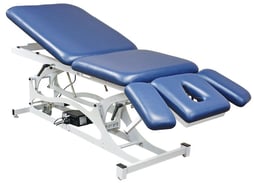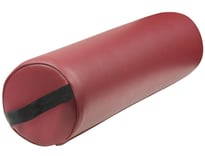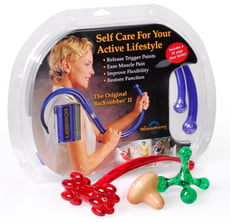by Mary Biancalana
For athletes who are training hard, the stabbing pain of plantar fasciitis is all too common. Most often, when pain is felt into the bottom of the foot, it is instantly diagnosed as “plantar fasciitis.” I say, let’s take a hard look at all the reasons there might be pain in the bottom of the foot and try to eliminate those reasons. And, let’s not be too quick to give a medical condition to everyone who experiences pain or discomfort.
So before you pull out that cold pack, ask yourself: What about trigger point therapy?
Trigger points, or contracted areas in muscle, are common causes of aches and pains, but are woefully under-diagnosed. Knowing which trigger points can cause or refer pain into the bottom of the feet can mean the difference between spending time on the bench or competing. Athletes or other clients who present with pain in the bottom of the foot are often told that they have plantar fasciitis even if there was no MRI performed. But if the plantar foot pain is actually due to trigger points in the gastroc or soleus muscles, these clues can help you determine if this is the case:- The athlete may feel a loss of strength or power when pushing off or jumping.
- The athlete may report a feeling of tightness in the calf or the feeling of being on the verge of a calf cramp if they point their toes strongly.
- The athlete has restricted range of motion in the ankle and/or in straight leg dorsiflexion.
If foot pain is due to a trigger point, most athletes and clients experience real and rapid relief once trigger point therapy is applied. Here’s how to get started.
 1. Invest in an elevating electric table.
1. Invest in an elevating electric table.
To spare your back and to help further athlete comfort, an elevating electric table is essential.
Some athletic training rooms only have static tables at one height, but I would promote having at least one elevating electric table in the training room. The ability to bring the table up to the height of the practitioner during trigger point and other therapies helps mitigate the impact of treatment on a provider. Also, athletes in pain will appreciate that a table that can be lowered so that they can more safely get on the treatment surface.
As a side note, if your practice or training room works with athletes who are physically challenged (such as paralympians or para-athletes), elevating electric tables help ensure that you are ADA compliant and mobility friendly.
 2. Provide support with a bolster.
2. Provide support with a bolster.
During treatment, your athlete will typically lay prone on your table. But while in this position, you don’t want them to be maximally resting on the top of the foot, which could cause calf cramping and additional pain. Make sure that your training room has sturdy bolsters that are easily accessible (not tucked away in a storage room) to provide support for the lower leg and ankle.
3. Assess the ability of the ankle to bend.
Full, pain-free dorsi flexion and plantar flexion are required for the lower leg muscles working properly. Key indicators of trigger points (besides taut, ropey fiber sections) can be any restrictions in the range of motion of the gastroc or soleus muscles. Many athletic trainers may not realize that those two muscles—which are located in the calf just above the Achilles tendon—harbor trigger points that can refer pain into the bottom of the foot.
By using a bolster to support the ankle while the calf is available to be treated, it’s easy to feel for dysfunctional fibers in the medial, uppermost gastroc and the lower one-third of the soleus.
4. Use the trigger point illustrations to help locate the most probable location of taut fibers and then apply trigger point pressure release or other manual therapy techniques.
Athletic trainers may already be familiar with these trigger point locations, but for a comprehensive guide, refer to Myofascial Pain and Dysfunction: The Trigger Point Manual, a two-volume set by Drs. Janet G. Travell and David G. Simons. Other helpful publications include the most recent addition to the trigger point family, The Trigger Point Therapy Workbook, Third Edition or my book, Trigger Point Therapy for Low Back Pain (see chapter 14).
 5. Athletic trainers should instruct athletes to continue careful active range of motion and home self-care. Self-applied trigger point pressure release may need to be done by the athlete during workouts, and before or after competition.
5. Athletic trainers should instruct athletes to continue careful active range of motion and home self-care. Self-applied trigger point pressure release may need to be done by the athlete during workouts, and before or after competition.
After treatment, athletes can resume regular activity with care and should also use at-home applications of compression. Many excellent tools are available for self-care compression into the gastroc/soleus muscles, including the Jacknobber, Knobble or The Original Backnobber.
As athletic trainers, you care about ensuring your athletes’ peak performance. Trigger point therapy is one way to help you get there. Trigger points can reduce athletes’ running speed, endurance and jumping abilities that are used in many different sports. With or without the presence of pain, they can also be the cause of athletes hitting a plateau, despite great training. But once a trigger point is deactivated and the muscle has been brought to its normal resting length, athletic performance improves almost instantly.
Mary Biancalana, owner of Trigger Point Sports Performance and the Chicago Center for Myofascial Pain, runs her own educational program for Advanced Trigger Point Education. She is a BOC- and NCBTMB-approved provider for athletic trainers as well as for massage therapists. For more information, visit www.chicagotriggerpointcenter.com.



